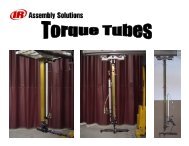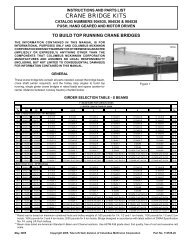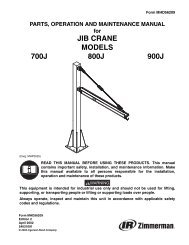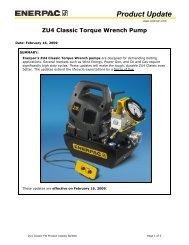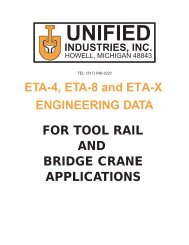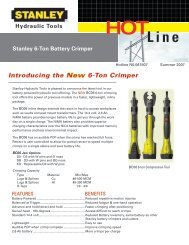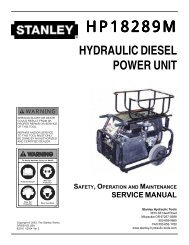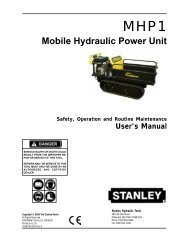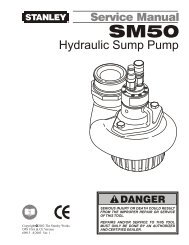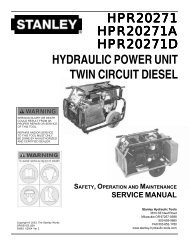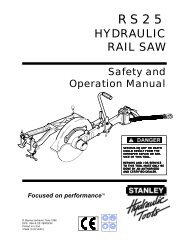Hydraulic Sinker Drill - Tool-Smith
Hydraulic Sinker Drill - Tool-Smith
Hydraulic Sinker Drill - Tool-Smith
Create successful ePaper yourself
Turn your PDF publications into a flip-book with our unique Google optimized e-Paper software.
2. Start the hydraulic supply and turn the circuit<br />
control valve to the "ON" position.<br />
3. Open the air valve on the tool just enough to permit<br />
a small amount of air to flow from the rock bit.<br />
Air flow must be continuous during drilling<br />
to avoid clogging of air passages and/<br />
or backflushing of waste products into the<br />
drill.<br />
4. Place the rock bit firmly on the surface to be drilled.<br />
5. Grip the handles on the tool firmly and open the<br />
hydraulic valve lever slightly to start the tool at a<br />
slow speed. Adequate down pressure is very<br />
important.<br />
6. Ensure the rock bit is rotating at a moderate speed<br />
(not too fast, not too slow). When starting the hole,<br />
it is best to start at a slow impact and rotation speed<br />
until the rock bit has carved out a depression in the<br />
material being drilled. If the rock bit is not rotating<br />
open the hydraulic valve lever further. If the rock bit<br />
still does not rotate adjust the motor control knob<br />
until rotation is achieved.<br />
7. After the rock bit has carved out a depression in the<br />
material being drilled, open the hydraulic valve<br />
lever fully. Readjust the motor control knob to<br />
obtain a good drilling speed. Adjust the air valve to<br />
ensure the cuttings are being extracted from the drill<br />
hole.<br />
8. When the bottom of the tool comes within 6 inches<br />
of the drill hole, it is time to either add another<br />
section of drill steel or replace the existing drill steel<br />
with a longer section. Close the hydraulic valve<br />
lever but leave the air valve "ON" and then lift the<br />
tool with drill steel and rock bit out of the hole.<br />
Leaving the air valve "ON" helps prevent cuttings<br />
from falling around the bit while the bit is lifted<br />
from the hole.<br />
9. When the tool, drill steel and bit have been removed<br />
from the drill hole, turn the valve lever "OFF" and<br />
turn the hydraulic supply circuit control valve<br />
"OFF" before changing the drill steel or rock bit.<br />
COLD WEATHER OPERATION<br />
If the tool is to be used during cold weather, preheat the<br />
hydraulic fluid at low engine speed. When using the<br />
normally recommended fluids, fluid temperature should<br />
be at or above 50° F/10° C (400 ssu/82 centistokes)<br />
before use.<br />
ROUTINE MAINTENANCE<br />
A very important maintenance practice is to keep the<br />
hydraulic fluid clean at all times. Contaminated hydraulic<br />
fluid causes rapid wear and/or failure of internal<br />
parts.<br />
Periodically apply a light coat of WD40 between the<br />
throttle lever and throttle valve and the motor control<br />
knob and motor control valve.<br />
Check the nitrogen charge in the accumulator. If low,<br />
recharge the accumulator. See the section titled "ACCU-<br />
MULATOR CHARGING" found later in this manual.<br />
STORAGE<br />
Disconnect all hoses and wipe the tool clean. Spray the<br />
interior of the drive hex and motor plate with WD40.<br />
Also apply a light coat of WD40 between the throttle<br />
lever and throttle valve and the motor control knob and<br />
motor control valve.<br />
Store in a clean, dry place.<br />
8



